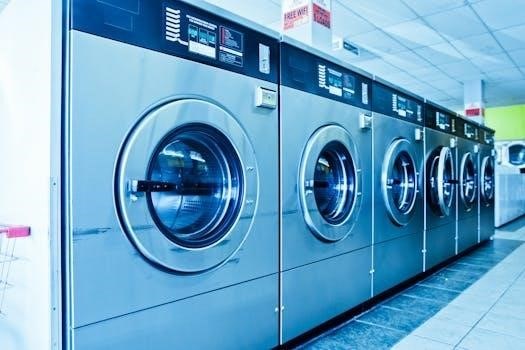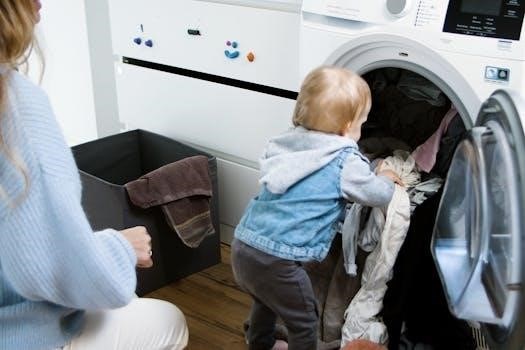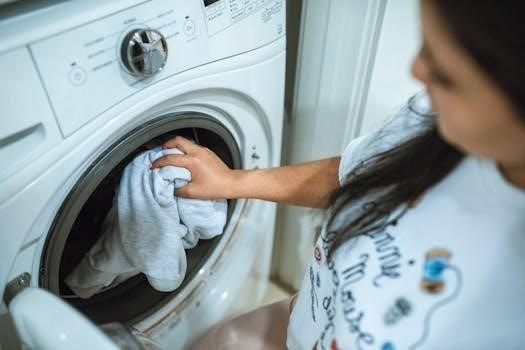Kenmore Top-Load Washer Error Codes⁚ A Comprehensive Guide
This comprehensive guide unlocks the secrets behind Kenmore top-load washer error codes. We will help you understand, diagnose, and resolve problems. Accessing DIY repair help is simplified with detailed information.
Understanding Kenmore Washer Error Codes
Kenmore top-load washers, especially models starting with 110, communicate problems through error codes. These codes appear on digital displays or via a flashing lid lock. Recognizing these codes is the first step in diagnosing issues. This guide focuses on 110 Model Kenmore top-load VMAX washers, providing explanations. Error codes indicate component malfunctions, helping pinpoint problems for DIY repairs.
Understanding these codes is crucial for efficient troubleshooting and repair. Common errors include fill issues (LF), drain problems (Ld), and load imbalances (uL). Overload errors (oL) and specific codes like F01 also have distinct causes. Skilled technicians provide insights into diagnosing and fixing error codes. This guide aims to empower you with knowledge.

Identifying Error Codes on Your Kenmore Top-Load Washer
Identifying error codes on your Kenmore top-load washer is essential for quick troubleshooting. Models with displays show codes directly. Other models use flashing lid locks to signal faults.
Error Codes on Models with Digital Displays
Kenmore top-load washers equipped with digital displays present error codes directly on the console. These codes offer immediate insight into potential issues, simplifying the diagnostic process. When a problem arises, the display will show a specific alphanumeric code. This code corresponds to a particular fault condition within the washing machine.
Consulting the washer’s manual or a comprehensive online guide is crucial for deciphering the meaning of each code. Common examples include “LF” for Long Fill, “Ld” for Long Drain, “uL” for Unbalanced Load, and “oL” for Overload. Knowing the code allows you to pinpoint the problem. Then decide if you can implement a DIY repair or require professional assistance.
The digital display streamlines troubleshooting. It makes it easier to identify and address problems efficiently. Utilizing these codes effectively can save time and money on repairs.
Lid Lock Flashing on Models Without a Digital Display
For Kenmore top-load washers lacking a digital display, the flashing lid lock LED serves as the primary indicator of a problem. Instead of showing a specific error code, the lid lock flashes in a specific pattern. This pattern signals that the washer has encountered a fault during operation.
Determining the exact issue requires careful observation of the flashing pattern. The frequency and sequence of flashes can indicate different types of errors. For instance, a certain number of flashes, followed by a pause, might represent a specific fault code. Consulting the washer’s manual is essential to understand the meaning behind each flashing sequence.
Once the error is identified, troubleshooting steps can be taken to resolve the problem. This could involve checking the lid switch, water inlet valves, drain pump, or other components. Understanding the flashing patterns allows for effective troubleshooting.

Common Kenmore Washer Error Codes and Their Solutions
Explore common Kenmore washer error codes like LF (Long Fill), Ld (Long Drain), uL (Unbalanced Load), and oL (Overload). Learn their causes and find effective solutions to resolve them.
LF (Long Fill) Error⁚ Causes and Solutions
The LF (Long Fill) error code on your Kenmore top-load washer indicates that the washer is taking too long to fill with water. Several factors could trigger this error. A common cause is a kinked or damaged intake hose restricting water flow. Inspect both the hot and cold water hoses for any visible obstructions or bends.
Another potential issue is clogged water inlet screens. These screens are located where the hoses connect to the washer and the water supply. Mineral deposits or debris can accumulate, hindering water flow. Cleaning these screens can often resolve the LF error.
Low water pressure can also cause this error. Ensure that your home’s water pressure is adequate. If the pressure is low, contact your local water utility company. Finally, a faulty water inlet valve might be the culprit. This valve controls the flow of water into the washer. If it’s malfunctioning, it may need replacement.
Ld (Long Drain) Error⁚ Causes and Solutions
The Ld (Long Drain) error code signals that your Kenmore top-load washer is taking too long to drain water. A clogged drain hose is a frequent cause. Inspect the hose for kinks, bends, or obstructions. Disconnect the hose and clear any debris.
A blocked drain pump can also lead to this error. The drain pump removes water from the washer. Small items like socks or lint can clog the pump. Access the pump and remove any obstructions. Refer to your washer’s manual for location and access instructions.
A faulty drain pump motor could also be the issue. If the pump motor is not functioning correctly, it won’t be able to drain the water efficiently. Test the pump motor for continuity and voltage. If it’s defective, replacement is necessary.
Finally, check the standpipe. If the standpipe is clogged, it can cause the washer to drain slowly. Ensure that the standpipe is clear of any obstructions.
uL (Unbalanced Load) Error⁚ Causes and Solutions
The uL (Unbalanced Load) error indicates that the load inside your Kenmore top-load washer is unevenly distributed. This can cause excessive vibration and prevent the washer from spinning properly.
Redistribute the load manually. Pause the cycle and rearrange the items in the drum. Make sure the load is balanced and not concentrated on one side. Avoid washing single heavy items like rugs or blankets alone. Add a few smaller items to balance the load.
Overloading the washer can also cause this error. Reduce the load size. Washing too many items at once can prevent proper balancing. Follow the manufacturer’s recommendations for load capacity.
Check the washer’s leveling. An unlevel washer can contribute to unbalanced loads. Use a level to ensure the washer is sitting evenly on the floor. Adjust the leveling feet as needed.
Worn suspension rods can also cause this error. Suspension rods support the drum and help maintain balance during the spin cycle. If they are worn, they may not provide adequate support. Inspect and replace them if necessary.
oL (Overload) Error⁚ Causes and Solutions
The oL (Overload) error on your Kenmore top-load washer signifies that the machine is attempting to wash too many items or items that are too heavy for its capacity. This error is a safety mechanism to prevent damage to the motor and other components.
Reduce the load size immediately. Remove some of the items from the washer to decrease the overall weight and volume. Refer to your washer’s user manual for the recommended load capacity.
Avoid washing bulky items in large quantities. Items like comforters, blankets, or towels can quickly overload the washer, even if they don’t seem excessively heavy individually. Wash these items in smaller batches or individually.
Ensure proper load distribution. Even if the total weight is within the limit, an unevenly distributed load can trigger the oL error. Redistribute the items in the drum to ensure a balanced load.
Check for waterlogged items. Heavy, water-soaked items can significantly increase the load weight. Ensure that items are not excessively wet before placing them in the washer. If necessary, pre-squeeze excess water.
F01 Error Code⁚ Causes and Solutions
The F01 error code on a Kenmore top-load washer typically indicates a motor or control board issue. This error suggests that the washer’s control system is unable to properly communicate with or control the motor, preventing the wash cycle from proceeding as expected.
First, try resetting the washer by unplugging it from the power outlet for about 1-2 minutes. Then plug it back in and see if the error code clears. This simple step can sometimes resolve minor electronic glitches.
Check the motor connections. Ensure all wires connected to the motor are securely attached and free from damage. Loose or corroded connections can disrupt communication and trigger the F01 error.
Inspect the motor itself for any signs of damage or wear. Look for burnt smells, unusual noises, or visible damage to the motor windings. If there’s clear evidence of motor failure, replacement may be necessary.
If the motor seems fine, the problem may lie with the control board. The control board is responsible for sending signals to the motor. If the control board is faulty, it may need replacement.

Troubleshooting Specific Kenmore Washer Problems
Let’s troubleshoot Kenmore washer problems! We can diagnose lid lock issues and address other common malfunctions. Using error codes, we can pinpoint issues and find effective solutions.
Diagnosing and Fixing Lid Lock Issues (e.g., F5 E3 Error)
The F5 E3 error code on your Kenmore top-load washer often points to a problem with the lid lock mechanism. This issue can prevent the washer from starting, spinning, or completing its cycle. Diagnosing the problem accurately is crucial for a successful fix. First, visually inspect the lid lock for any physical damage or obstructions. Ensure that nothing is blocking the lid from properly engaging with the lock.
Next, check the wiring connections to the lid lock. Loose or damaged wires can disrupt the electrical signals, causing the error. If the wiring appears intact, the lid lock switch itself may be faulty. Use a multimeter to test the switch for continuity. If there’s no continuity, replace the lid lock switch. Furthermore, consider the possibility of a faulty control board. While less common, a malfunctioning control board can send incorrect signals to the lid lock, triggering the F5 E3 error. Replacing the control board might be necessary if other solutions fail.
Finding DIY Repair Help and Parts
Fixing your Kenmore washer yourself is possible! Access repair help and source necessary parts online. Use online resources for troubleshooting and step-by-step repair instructions. Find diagrams, videos, and expert advice.
Utilizing PartsDirect Repair Help Section
The PartsDirect repair help section is a valuable resource for diagnosing and fixing issues with your Kenmore top-load washer. This section provides comprehensive support for various appliances, including washing machines, lawn equipment, and more. You can find repair assistance for different models, including the 110 series.
The platform offers DIY repair guides, troubleshooting tips, and video tutorials to guide you through the repair process. By utilizing this resource, you can identify the cause of the error code displayed on your washer and find step-by-step instructions for resolving the problem. It also details which parts you may need to replace.
PartsDirect focuses on providing solutions for common issues, ensuring you have the necessary information to complete the repair successfully. Whether it’s a simple fix or a more complex repair, PartsDirect’s repair help section is designed to empower you to tackle the job with confidence.

Additional Resources⁚ Parts Lists and Diagrams
Explore additional resources, including detailed parts lists and diagrams, for Kenmore top-load washers. These visual aids are invaluable for identifying components and understanding the assembly of your specific washer model.
Exploded Parts List for Kenmore Heavy Duty Top Load Washer Model 110.92273100
This section provides an exploded parts list and detailed diagrams specifically for the Kenmore heavy-duty top-load washer, model number 110.92273100. The comprehensive list includes over one hundred individual components, allowing for precise identification of each part within the washing machine’s assembly. These diagrams are invaluable for troubleshooting, repairs, and part replacements. You can easily locate and order the correct replacement parts for your specific Kenmore model.
The exploded view assists in understanding how the washer is constructed, from the cabinet and drum to the motor and control panel. The parts list provides corresponding part numbers, descriptions, and availability. Utilize this resource to effectively diagnose issues, plan your repairs, and ensure you order the correct parts. It ensures accurate repairs and extends the lifespan of your appliance, ensuring seamless operation for years to come.

